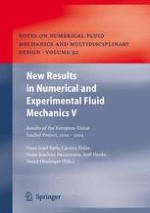2006 | Buch
New Results in Numerical and Experimental Fluid Mechanics V
Contributions to the 14th STAB/DGLR Symposium Bremen, Germany 2004
herausgegeben von: Prof. Dr. Hans-Josef Rath, Carsten Holze, Dr. Hans-Joachim Heinemann, Rolf Henke, Professor Dr. Heinz Hönlinger
Verlag: Springer Berlin Heidelberg
Buchreihe : Notes on Numerical Fluid Mechanics and Multidisciplinary Design
